30.04.19
New from Tobermory, Big Peat and Compass Box, Blue Sky Thinking from Whyte & Mackay, Diageo Archives & More
Well, now that we’re properly into spring here in Scotland, more tasty new expressions are coming out to tempt you and your customers. As I was just starting to type this up a delivery came of a new Glengoyne expression and a letter from Highland Park to tell me that my sample of Twisted Tattoo is on its way and to remind about their retail store in Kirkwall, on Orkney, which will open in early May. Work from local artists will be presented as well as other brand partnerships (no detail yet).
Before getting down to the main items this month, though, we should note that Ardnahoe, Islay’s newest distillery, had its official opening mid-April and I was so disappointed at not being able to go as it clashed with another commitment. I saw it from the hill above when it was still a construction site at last year’s Feis Ile (Islay Festival) and I’m arranging a one woman tour with their nice communications lady so I hope to see round and ask lots of questions at this year’s whisky fest late in May. So a possible report on it from me in June.
 One venue I did finally get to is the Diageo Archives. I’ve had a standing invitation there for a while (years!) and it was only when there briefly with a Swiss film maker in March, that I finally set a date to go back. Quite timely really as they’ve been refurbishing, particularly the liquid library room where they need more sample space. The archives are not open to the public but used as a resource for Diageo employees and distributor companies worldwide in many sectors of the business from production to marketing. Indeed, they are encouraged to come. Local politicians, Diageo suppliers and local community groups have been hosted there, though. To a history enthusiast like me, it’s treasure trove. I spent a while there in the company of Archive Manager, Christine McCafferty finding out a bit about her as well as the archives themselves.
One venue I did finally get to is the Diageo Archives. I’ve had a standing invitation there for a while (years!) and it was only when there briefly with a Swiss film maker in March, that I finally set a date to go back. Quite timely really as they’ve been refurbishing, particularly the liquid library room where they need more sample space. The archives are not open to the public but used as a resource for Diageo employees and distributor companies worldwide in many sectors of the business from production to marketing. Indeed, they are encouraged to come. Local politicians, Diageo suppliers and local community groups have been hosted there, though. To a history enthusiast like me, it’s treasure trove. I spent a while there in the company of Archive Manager, Christine McCafferty finding out a bit about her as well as the archives themselves.
The archive collection used to be housed at Diageo’s massive bottling plant in Leven, Fife and was originally established by Dr. Nick Morgan in 1990. There was a concern that many things might disappear as they were scattered over various locations as all the Diageo companies held their own materials. It was moved in 2000. Some items were held by individuals too and the archive has been added to ever since it was formed with brand expressions, packaging, marketing materials, documents, books and advertisements. They’ve even found some things, mainly promotional materials, on e-Bay.
What Christine says they find missing more than anything is old documentation. It’s a business archive rather than one about the various families (though the Johnnie Walker archive is the most complete) and the idea is they want to share the brand stories with all linked to Diageo to make them feel connected to and impassioned by the history and brands. Having seen it all, that wouldn’t be hard. It’s there to be nurtured and looked after for future generations in the company to provide learning and knowledge. I guess to go forward, you need to know where you’ve come from.
As well as the huge liquid library, there is a Founders’ Room with photos of the 19th century founding fathers (and one mother!) of various major Diageo brands as well as copies of old 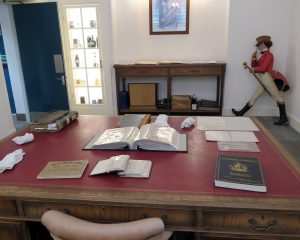 documents containing blending notes and even the documents detailing the results of the Walker farm sale when the family had to let it go. It’s a reminder that pioneering individuals started these businesses and that it’s still all about people. It also helps to engage overseas corporate visitors when, for example, the Chinese distribution team can be shown a Johnnie Walker presence in China back in 1910. It’s a connection and a good story for them to tell at home.
documents containing blending notes and even the documents detailing the results of the Walker farm sale when the family had to let it go. It’s a reminder that pioneering individuals started these businesses and that it’s still all about people. It also helps to engage overseas corporate visitors when, for example, the Chinese distribution team can be shown a Johnnie Walker presence in China back in 1910. It’s a connection and a good story for them to tell at home.
Further down in the building there is a huge room housing founders’ writing desks, a vast document collection, advertisement examples and promotional materials such as mirrors, ashtrays, water jugs and so much more like old video and cine-film. I could happily spend months in 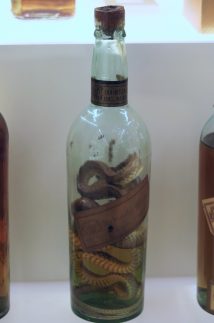 there as well as time in the liquid library minutely examining all the bottles. It’s not just Scotch Whisky either but gins, vodkas, rums, Canadian whisky and plenty more. The most lurid one is a bottle which came back, probably from the Far East, with a snake in it. The bottle isn’t full either so the snake may have to be topped up by injecting through the stopper to keep it “pickled”! There are also some rare gems such as a Queen’s Diamond Jubilee bottling, a blend of whiskies from 1952. The library holds some 5,000 bottles from the 1880’s to present day and is very useful to chart the evolution of packaging and familiar brand elements as new packaging is developed. After all, the walking man hasn’t always been on the Johnnie Walker labels and bottles. He didn’t appear till the early 20th century. All of these materials are kept in temperature controlled conditions and white gloves have to be used as necessary to touch them.
there as well as time in the liquid library minutely examining all the bottles. It’s not just Scotch Whisky either but gins, vodkas, rums, Canadian whisky and plenty more. The most lurid one is a bottle which came back, probably from the Far East, with a snake in it. The bottle isn’t full either so the snake may have to be topped up by injecting through the stopper to keep it “pickled”! There are also some rare gems such as a Queen’s Diamond Jubilee bottling, a blend of whiskies from 1952. The library holds some 5,000 bottles from the 1880’s to present day and is very useful to chart the evolution of packaging and familiar brand elements as new packaging is developed. After all, the walking man hasn’t always been on the Johnnie Walker labels and bottles. He didn’t appear till the early 20th century. All of these materials are kept in temperature controlled conditions and white gloves have to be used as necessary to touch them.
In addition, there is a digital archive – and specialist digital archivist – taking care of websites and social media aspects. The team there is keen that the archive should reflect the way business is done in each generation. It may even be that a VR can be used in future also. Much of the collection is digitised for preservation now too which helps when other parts of the company e.g. distilleries, might want to use material. It can be sent in digital form or reprinted so that originals can stay protected.
I found out so much more but what about Christine herself? She and her team are all qualified archivists. How does one obtain that, I wondered? These days there are postgraduate qualifications in archive studies but it wasn’t always thus. After university, Christine pursued her archive studies in London but now there are courses at Glasgow and Dundee universities too. She started her working life in the Northumberland Records Office tracing family trees but that became a bit too repetitive so she left and worked at Heriot Watt university for a couple of years before moving to Diageo where she found more than enough of interest to make her stay. It rather looks as though she’s still enjoying it hugely too. I think it’s one of the few jobs I’ve envied.
Early this month, I was at the launch of Distell’s new Tobermory 12 Year Old signature expression (46.3% alc. vol.) and another fine piece of work from Master Blender, Dr. Kirstie McCallum. An interesting venue in the shape of a former glue factory on the north side of Glasgow, now used as studio and event space. The new Tobermory is linked very much to the art and craft of the island and the exhibition featured on the night included lovely photography of the island (also featured on the pack) and works from the distillery’s first artist-in-residence. A couple of part-finished paintings were like the “painting by numbers” kits a lot of us may have had as children with numbered paint pots on casks beside them. I wasn’t sure if we were meant to fill in the blanks with these pots but braver souls than I did have a go and no one yelled at them to stop. Kirstie and marketing colleague Amy were on hand to tell us more about this new bottling. Basically they felt that Tobermory had so much good quality inventory that was perhaps not living up to its fullest potential and this expression is the result. The spirit is matured for 12 years in US oak.
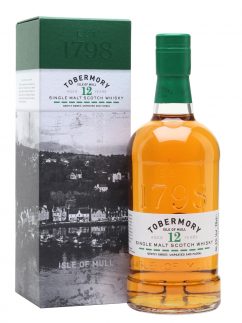 My tasting note is:
My tasting note is:
Appearance – Deep medium gold with old gold and brass glints. Tears quite clingy and fat.
Nose – Citrus oils (mainly clementine); some sweetness; ginger and other sweet spices; sea air and grasses. With water, there’s a dab of brown sugar plus some caramel; oak vanilla and milk chocolate.
Palate – Orange oil, spices, little bits of saltiness, some vanilla and sweet notes as well as toasted barley (but bear in mind Tobermory expressions don’t use peat). Medium mouthfeel.
Finish – Fairly long with spice and sweetness.
A very rewarding dram. We got to try the Ledaig 18 Year Old too which is so worth seeking out if you haven’t tried it. It’s made at Tobermory too but using peated barley.
The second new one tried this month is from Compass Box and is called Affinity (46% alc. vol.). Whisky and Calvados anyone? Obviously this cannot be called a Scotch Whisky as it  it’s a blend of the Scottish and French spirits (another Auld Alliance?) and tastes great. I love the creativity of these guys. This would be a brilliant cocktail base. The whiskies are a blend of Highland malts and some Craigellachie from Speyside. The calvados is from Domaine Christian Drouin.
it’s a blend of the Scottish and French spirits (another Auld Alliance?) and tastes great. I love the creativity of these guys. This would be a brilliant cocktail base. The whiskies are a blend of Highland malts and some Craigellachie from Speyside. The calvados is from Domaine Christian Drouin.
Appearance – Rich, sunshine gold. Tears quite liquorous and clingy.
Nose – Juicy and spicy (cinnamon and clove) ; definitely appley; jasmine notes as well as dried stone fruits and some from the vine; also a touch o f oil of clarysage from colognes. With water, it’s a little softer and a bit flatter at first; a bit of marzipan peeps through- definitely almond notes; Left alone a while some varnish notes develop plus oak vanilla, herbal oils and more dried fruit.
Palate – quite a light mouthfeel with flavours of marzipan and dried fruits, vanilla and baked apples with syrup.
Finish – Medium – fairly long with baked apple flavours lingering alongside almonds oak and some sweetness.
Compass Box has another new release called No Name, No. 2, a new Limited Edition blended malt Scotch whisky and the release was embargoed till today (30th April) Bottled at 48.9% ABV, a total of 8,436 bottles of No Name, No. 2 have been released worldwide. It’s available in the UK and select international markets from April 2019, and in the USA from September 2019. SRP £110/$145. Samples are still to be sent out so no tasting note as yet.
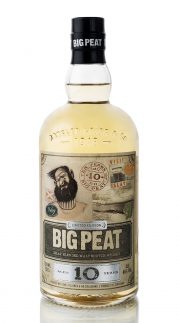 My last tasting note for this month comes from Douglas Laing & Co as they launch Big Peat 10 Years Old (46% alc.vol.). I’ve tasted Big Peats in previous years but think this might be my favourite so far.
My last tasting note for this month comes from Douglas Laing & Co as they launch Big Peat 10 Years Old (46% alc.vol.). I’ve tasted Big Peats in previous years but think this might be my favourite so far.
Appearance – Pale straw/lemon- a bit like a young Muscadet. DL uses no added colour in these whiskies. Very clear and bright. Tears quite clingy and close together.
Nose – Smoked cheese; embers; slight sweaty sock. Also some sweetness; a touch of oak and light dried fruit; some sea air and a touch of rubber. With water, more demerara sugar and toasted barley.
Palate – Malty barley; smoke; peatiness; iodine; salt; tar and char. Quite a chewy whisky.
Finish – Long, smoky with plenty of toasted barely and charred wood sweetness.
I think it’s the sweet notes in this one that edge it for me over some of its predecessors.
Please note this isn’t this year’s Feis Ile edition of Big Peat- that’s another bottling entirely. A surprise sample, also from Douglas Laing, arrived in the form of their Old Particular Elements Fire Edition – Craigellachie 12 Year Old at 54.3% alc. vol. Tasting note next month if there’s room.
Last month, I mentioned the first outcomes from Whyte & Mackay’s Whisky Works project under the direction of blender, Gregg Glass. I was able to have a short chat with him about it later on. Apparently he’s had some of the concepts and structure in his head for a while and it was good to get started with it all in earnest at W&M where there is scope for independent innovation alongside the brand work. The project is to be an incubator for processes and approaches to whisky creation. Gregg wants to focus on expertise across all areas of the industry and tap creative potential across the board – be more collaborative. He calls it a “tree to tastebud” approach.
All bottlings will be one-offs and numbered, with batch variances. Longer term, if people collect these expressions, they will see variances. The distribution will be in UK only for now but he is thinking about where else to go from here and there’s no pressure. Only freedom to experiment. To spread the word round the company he’s been doing presentations at all the company sites, including the distilleries, as art f the W&M 175th anniversary year. Coopers will be trained in building individual casks from start to finish – a bit like an expensive car engine bearing the name of the person who built it. He’s already had help from Darren, the foreman at Speyside Cooperage, in the use of Scottish oak which is wilder and more prone to being porous. The cask they built for one of the new expressions sprang a leak when tested and they had to use the one spare stave available from the wood they had used for that cask. Talk about cutting things fine! I look forward to hearing more about the results of this project as they come out.
While I’ve been writing this today, one of my drinks trade news digests tells me that a female distiller in Scotland is offering two internships in all aspects of production – and cocktail making – to two women to encourage more women to get into the production side of the industry. It takes the form of a competition and the deadline to apply is 16th May. She’s quoted as saying she wants to challenge outdated views around Scotch Whisky being more for/made by men and hence the gender imbalance on the production side. I have to say this may be good PR and a it’s very reasonable idea (though I wonder if women only entrants is legal) but is the statement itself maybe not up to date? Does it maybe depend on the market you are in and the age of the people you are talking to? That imbalance is shrinking little by little and it may be that we need to educate career advisers and encourage more girls into studying subjects that matter in producing whisky, not to mention stressing that it’s not always as physical a job as it once was. We do have female coopers too, which is more physical but isn’t a barrier. I’ve been interviewing women in Scotch Whisky production (not just blending) for years now and there are whisky production women in a number of companies. Most notable is Diageo but they are also at Glengoyne (Ian Macleod Distillers) as well as other places. By fronting up major brand activity e.g. at whisky festivals and postings on social media, with female blenders, distillers and distillery workers, people have become much more aware of women involved in whisky making. No harm in trying for more, though!
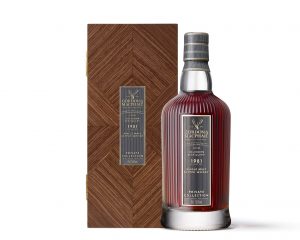 Elsewhere in Scotch Whisky world, single malt whisky creator Gordon & MacPhail has announced its Spring Collection, “unveiling a series of stunning whiskies which draw upon the unrivalled depth and breadth of knowledge the company has gained from maturing spirit from over 100 Scottish distilleries. One of the highlights of the Spring Collection is the Gordon & MacPhail 1981 from Coleburn Distillery which is the latest edition to the ‘Private Collection’ range. This exceptional whisky has been maturing in the company’s specially selected cask at its warehouse in Elgin for 38 years. Spirit from Coleburn Distillery – mothballed in 1985 – was traditionally used in blending but Gordon & MacPhail carefully matched the spirit with a refill Sherry hogshead to create this extraordinary and very rare single malt. Coleburn Distillery was founded in 1897 in Longmorn, five miles south of Elgin in Speyside. Designed by renowned architect Charles Doig, who also designed the Gordon & MacPhail retail shop in Elgin, the distillery was one of many that closed its doors during a challenging period for the whisky industry in the 1980s. Laid down on 11th March 1981 to mature in cask 476, Gordon & MacPhail 1981 from Coleburn Distillery was bottled at 55.9% ABV on 14th March 2019. With a distinct mahogany hue, the new release has rich flavours of Sherry-soaked fruit, liquorice, and dark chocolate, and a long finish brimming with toffee notes and a hint of smoke.” Only 101 bottles will be available for purchase worldwide and the price is around £1250 in the UK. Price will vary by market and is not available in the US.
Elsewhere in Scotch Whisky world, single malt whisky creator Gordon & MacPhail has announced its Spring Collection, “unveiling a series of stunning whiskies which draw upon the unrivalled depth and breadth of knowledge the company has gained from maturing spirit from over 100 Scottish distilleries. One of the highlights of the Spring Collection is the Gordon & MacPhail 1981 from Coleburn Distillery which is the latest edition to the ‘Private Collection’ range. This exceptional whisky has been maturing in the company’s specially selected cask at its warehouse in Elgin for 38 years. Spirit from Coleburn Distillery – mothballed in 1985 – was traditionally used in blending but Gordon & MacPhail carefully matched the spirit with a refill Sherry hogshead to create this extraordinary and very rare single malt. Coleburn Distillery was founded in 1897 in Longmorn, five miles south of Elgin in Speyside. Designed by renowned architect Charles Doig, who also designed the Gordon & MacPhail retail shop in Elgin, the distillery was one of many that closed its doors during a challenging period for the whisky industry in the 1980s. Laid down on 11th March 1981 to mature in cask 476, Gordon & MacPhail 1981 from Coleburn Distillery was bottled at 55.9% ABV on 14th March 2019. With a distinct mahogany hue, the new release has rich flavours of Sherry-soaked fruit, liquorice, and dark chocolate, and a long finish brimming with toffee notes and a hint of smoke.” Only 101 bottles will be available for purchase worldwide and the price is around £1250 in the UK. Price will vary by market and is not available in the US.
At the start I mentioned the new sample from Glengoyne. The latest release in the Glengoyne Cask Strength series, Cask Strength Batch No. 007 is the first in the collection to feature a small proportion of bourbon barrels in the cask recipe. It’s bottled without chill-filtration at 58.9% alc. vol. and has been crafted using a combination of first-fill European and American oak oloroso sherry casks, refill casks and bourbon barrels. It retails at £59.99 per 70cl bottle, and is now available to purchase at www.glengoyne.com . As it’s a late arrival, no time for tasting notes here so late May for that one too.

I’m intending to be on Speyside later this week for a Benriach event at the Speyside Whisky Festival so will look forward to telling you more about that near end of May before going off to Islay to do my annual whisky dinner.
Slainte,
Caroline
Comments